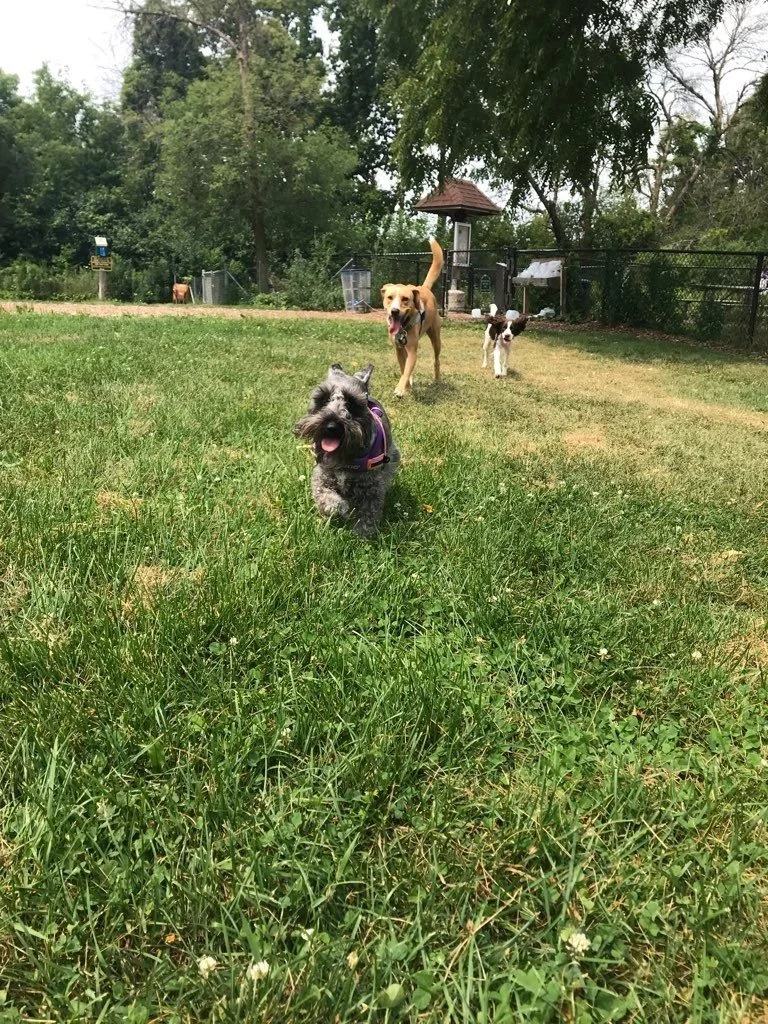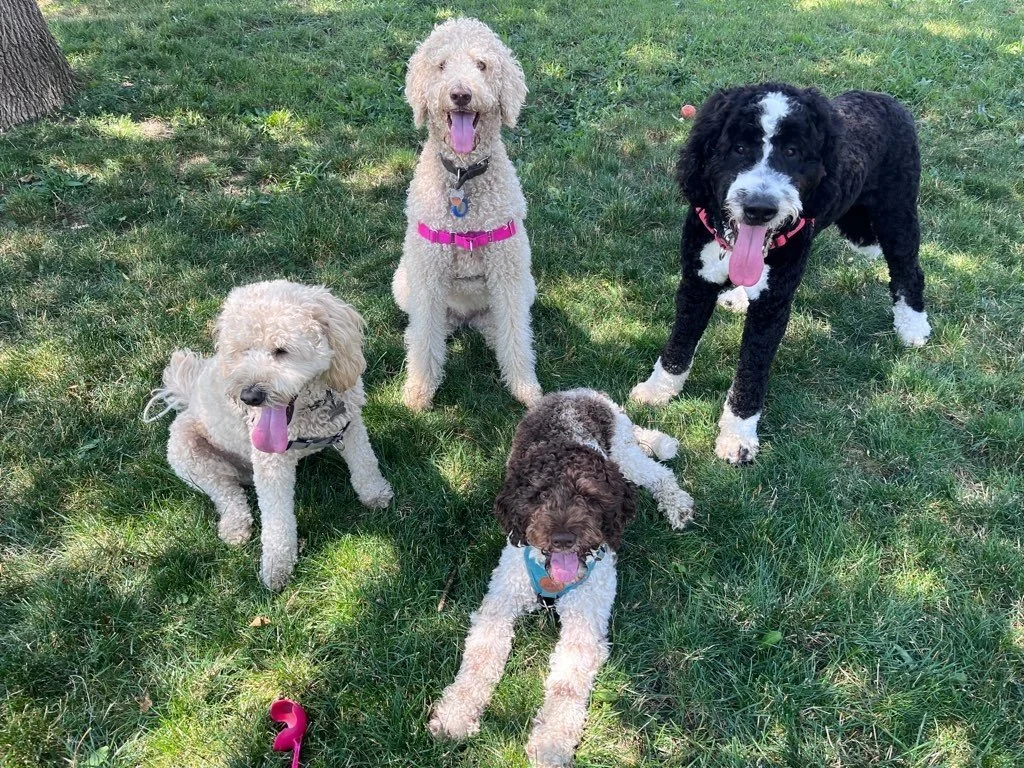Dog owners rejoice – Milwaukee is a haven for our canine companions, boasting an array of fantastic dog parks that offer a slice of canine paradise. From the serene beauty of Estabrook Park to the spacious play areas of Currie Dog Park, Milwaukee's dog parks provide an ideal backdrop for four-legged frolics. Yet, amid the tail-wagging excitement, it's paramount to ensure that every visit to these canine wonderlands is safe and enjoyable for both your furry friend and fellow park goers. At Off Leash MKE, we're committed to prioritizing your pet's well-being and fostering a sense of community among dog lovers. Continue reading as we dig into the advantages and potential pitfalls of dog park visits, explore essential safety guidelines, and offer recommendations to make your outings to Milwaukee's dog parks truly memorable.
Advantages of Dog Park Use
Before we dive into safety guidelines, let's highlight some of the advantages of visiting dog parks:
Socialization
Dog parks provide an excellent opportunity for your furry friend to interact with other dogs, helping improve their social skills. Dogs, like humans, thrive on social interaction. Dog parks offer a controlled and safe environment where your pup can engage with other dogs of varying breeds, sizes, and temperaments. This exposure is crucial for their social development. It teaches them to read and interpret canine body language, facilitating better communication and understanding when encountering new dogs in different settings. Additionally, regular socialization at dog parks can help reduce fear or anxiety-related aggression, making your dog a more well-adjusted and confident companion.
Behavioral Learning
Dogs can learn essential behavioral lessons from observing and interacting with other well-behaved dogs. The saying "monkey see, monkey do" applies to dogs as well. When your pup interacts with other dogs who exhibit good behavior, they are more likely to model that behavior. This learning process can include everything from basic commands like sitting and staying to more complex social cues such as sharing toys or respecting personal space. Dog parks become a natural training ground where your pet can pick up valuable lessons from their peers. This is especially beneficial for young dogs or newly adopted dogs who may not have had much exposure to well-behaved canines before visiting the park.
Physical and Mental Stimulation
The playtime and exercise your dog gets at a park can leave them tired and content. Dogs are inherently active creatures, and they need both physical and mental stimulation to remain happy and healthy. Dog parks offer a perfect balance of both. The free play and exploration in a dog park provide an outlet for your dog's boundless energy. This physical activity helps maintain a healthy weight, strengthens muscles, and improves cardiovascular health. Furthermore, the mental stimulation of navigating a dynamic social environment, with different dogs and new scents, can tire them out mentally, leaving your furry friend content and less prone to boredom-related destructive behaviors at home.
Building Connections
You can also meet like-minded dog owners who share your love for pets and the bond you have with your furry companion. Dog parks are not just for your pup; they're a social gathering place for dog owners as well. These parks often become a hub for a diverse group of people, all brought together by their shared love for dogs. It's an opportunity to connect with like-minded individuals who understand the joys and challenges of pet ownership. You can exchange tips, share stories, and even find new friends who might become your go-to companions for future dog park visits or playdates. These human connections can be just as rewarding as the canine ones, fostering a sense of community and support among dog owners in your area.
Potential Disadvantages of Dog Park Use
While dog parks offer many benefits, it's essential to be aware of potential downsides:
Negative Experiences
A single adverse incident at a dog park can have lasting consequences on your furry companion's behavior. An unpleasant encounter, whether it involves aggression, intimidation, or fear, can leave your dog feeling anxious and apprehensive around other canines. This fear may translate into aggressive behavior or excessive timidity in future social situations, hindering their ability to form positive relationships with other dogs and humans alike.
Overstimulation
Frequent visits to dog parks, while exhilarating, can inadvertently desensitize your dog to the stimulating environment. The constant excitement and interaction at the park can create a tolerance for such high levels of stimulation. As a result, your dog may find it challenging to unwind and relax in quieter settings, leading to restlessness or difficulty adjusting to the comparatively serene atmosphere outside the park.
Stressful Events
Stressful occurrences within the confines of a dog park can trigger chemical changes in your dog's brain. These changes can affect their ability to cope with novel stimuli encountered beyond the park's boundaries. Such stressors can range from altercations with other dogs to overcrowding or unfamiliar noises. Over time, these experiences can erode your dog's confidence and impact their overall well-being, making it essential to monitor their responses and provide support when needed.
Understanding these potential downsides empowers dog owners to make informed decisions about their park visits, ensuring that the benefits of socialization and exercise are maximized while mitigating potential challenges.
Basic Dog Park Guidelines
Now, let's explore some basic guidelines to ensure a safe and enjoyable dog park experience:
Age and Vaccinations
Safety begins with health, and it's imperative that dogs under 16 weeks old or those not up-to-date on vaccinations steer clear of the park area. This measure protects both your pup and others from potential health risks. Additionally, dogs that are feeling unwell should also refrain from park visits to prevent the spread of illness.
History of Aggression
A history of aggression towards other dogs is a red flag that should not be ignored. Dogs with such tendencies should not be brought into the park, as it can lead to dangerous situations and stress for other visitors. Prioritizing the well-being of all dogs means making responsible choices based on their temperament and past behavior.
Crowded Parks
While bustling parks can be exciting, it's often best to avoid overly crowded ones. Overcrowding can induce stress in dogs and increase the likelihood of conflicts. Whenever possible, opt for larger parks that offer more room for dogs to roam and play freely without feeling overwhelmed.
Trust Your Instincts
A crucial aspect of responsible dog park visits is trusting your instincts. Always assess the behavior of other dogs in the park. If you feel uncomfortable or sense potential trouble, it's best to err on the side of caution and leave. Your intuition is a valuable tool in ensuring your dog's safety.
Frequency and Duration
Lastly, moderation is key. Limit your visits to the dog park to 1-2 times per week, and keep sessions to a maximum of 30 minutes. This prevents over-stimulation and ensures that your dog can enjoy the park without becoming overly tired or stressed. Balancing park visits with other forms of exercise and mental stimulation contributes to a well-rounded and contented canine companion.
Recommendations for Dog Safety
To ensure a positive experience, consider the following recommendations for your dog:
Reliable Recall
One of the fundamental commands for dog park visits is reliable recall. This means your dog should respond promptly when called. A strong recall ensures you can regain control in case your dog starts to wander too far or encounters a potentially tricky situation. It's an essential safety measure that fosters confidence in your dog's off-leash adventures.
No Aggression History
Safety for all park-goers hinges on the absence of aggression in visiting dogs. Before bringing your pup to a dog park, it's imperative that they have no history of aggression towards other dogs or humans. This precautionary step helps maintain a harmonious environment where dogs can interact positively, play, and socialize without fear of conflicts.
Collar Choice
The type of collar your dog wears also plays a role in their safety during park visits. Opt for a regular flat collar instead of choker-style collars or similar variations. Choker-style collars can pose a risk of injury during play, especially if dogs engage in enthusiastic roughhousing. A flat collar provides a safer and more comfortable option for your dog.
Spaying or Neutering
Promoting responsible pet ownership is crucial in a communal setting like a dog park. To benefit the collective well-being of all dogs at the park, it's advisable that your dog be spayed or neutered. This not only helps prevent unplanned pregnancies but can also reduce territorial behavior and potential conflicts, contributing to a more relaxed and enjoyable atmosphere for everyone.
Milwaukee's dog parks are a treasure trove of joy and socialization for both dogs and their owners. They provide the perfect setting for your furry companion to run, play, and make new friends while you connect with like-minded pet enthusiasts. However, let's not forget that safety, responsibility, and community spirit are the cornerstones of every successful dog park visit. Before you embark on your adventures, ensure that your dog is licensed by your municipality, up to date on vaccinations, and that you possess a valid dog park pass. These requirements are not just rules; they are essential to maintaining the well-being of all parkgoers and their pets. By adhering to these guidelines and recommendations, you can guarantee that your visits to any of the great dog parks around Milwaukee are not only enjoyable but also safe and responsible. So, leash up, grab your pass, and embrace the moments spent bonding with your beloved pet in the great outdoors – Milwaukee's dog parks await!








Celebrate 2025 with Off Leash MKE! Explore our favorite blog posts on dog training, puppy socialization, enrichment activities, and team & pet highlights. Learn, play, and get inspired for 2026!